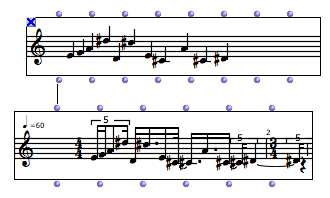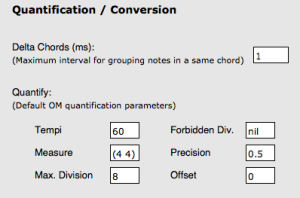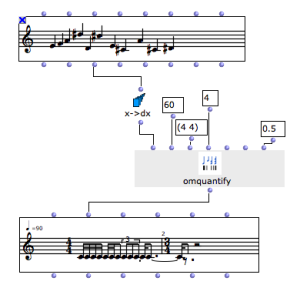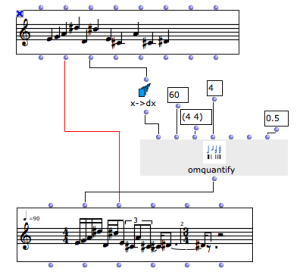| Navigation : Previous | Next |
Quantification
Quantification is the name of the process allowing to convert absolute durations (for instance, in milliseconds) into a structured rhythmic sequence of measures with metrics and pulse subdivisions.
In other word and with OpenMusic objects, this is basically what happens when converting a chord-seq , or a MIDI file oject into a voice.

Quantification is not an easy task : it implies preliminary information and adapted approximations in order to be performed correctly. When importing MIDI files into a voice, for instance, the tempo and metrics information can be used to better deduce the rhythm corresponding to the raw sequence of onsets encoded in the MIDI file.
Quantification Parameters
In order to guide the quantification processes, some general parameters can be
set in th OM Preferences (Quantification tab): allowed/forbidden rhythmic
subdivisions, tempo, time signatures, etc.
Even though, some notes in the original sequence may be lost during quantification. In this case, the following message will appear :
Warning: with the given constraints, n notes are lost while quantizing
In this case, the quantification parameters should probably be changed in order to better match the rhythmic constraints with the initial durations of the sequence.
Quantification Box
When specific or precise quantification processes need to be performed, you will generally need to use the OMQUANTIFY box in order to convert a duration list (typically coming from chord-seq s or similar data) into a rhythmic tree suitable to a voice object initialization.
About Rhytmic Trees
The main input of OMQUANTIFY is a list of durations.
The orther parameters are similar to the quantification preferences parameters, but they will apply only to this particular quantification process.
Duration from a Chord-Seq
The X- >DX function can be used to compute a list of durations starting from the list of onsets of a chord-seq object.
Note that OMQUANTIFY only processes durations to compute a rhythm tree.
Use the pitch information from the initial chord-seq in order to set the voice’s chords slot.
Contents :
- OpenMusic Documentation
- OM User Manual
- Introduction
- System Configuration and Installation
- Going Through an OM Session
- The OM Environment
- Visual Programming I
- Visual Programming II
- Basic Tools
- Score Objects
- Presentation
- Rhythm Trees
- Score Players
- Score Editors
- Quantification
- Export / Import
- Maquettes
- Sheet
- MIDI
- Audio
- SDIF
- Lisp Programming
- Reactive mode
- Errors and Problems
- OpenMusic QuickStart
| Navigation : Previous | Next |


